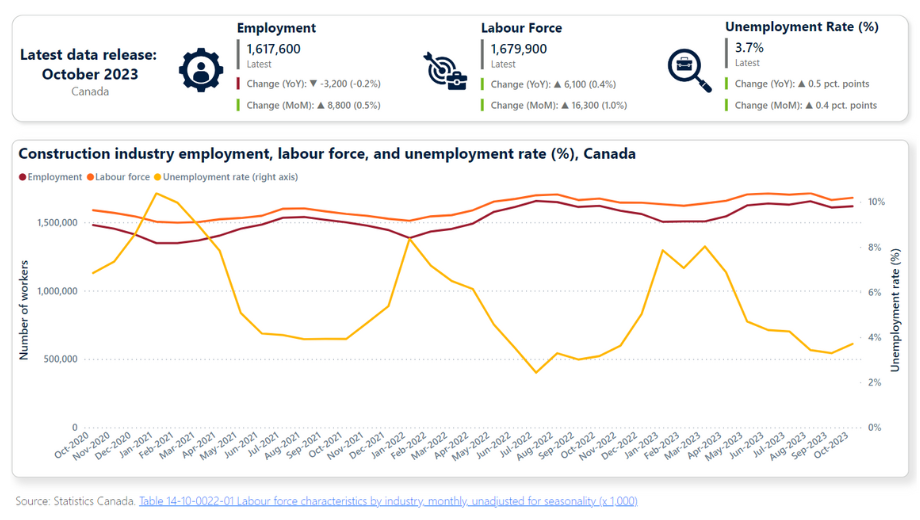The latest release of Statistics Canada’s Labour Force Survey (LFS) finds all-industry employment slowing as 2023 draws to a close. Employment was almost unchanged in October, with the addition of 18,000 workers (+0.1%) for the month. That follows increases of 64,000 workers (+0.3%) in September, and 40,000 (+0.2%) in August.
The employment rate—which is the proportion of the population aged 15 and older who are employed—fell by 0.1 percentage points to 61.9%, as the labour force grew by 85,000 workers, or 0.3%. Since January 2023, employment growth has averaged 28,000 per month, while growth in the population aged 15 and older in the LFS has averaged 81,000 per month. As a result, the national, all-industry unemployment rate rose 0.2 percentage points to 5.7% in October – the fourth increase in the last six months. Since April, the rate has increased by 0.7 percentage points, after holding steady at a near record-low of 5.0% between December 2022 and April 2023.
Employment among youth aged 15 to 24 and among core-aged (aged 25 to 54) men and women was almost unchanged in October. Gains were largest among men aged 55 and older, with employment rising by 31,000 (1.3%) in that cohort in October. Employment among women in the same cohort was unchanged.
Data for the October LFS was collected during the week of October 8 to 14.
Construction data again suggests easing labour conditions
A closer look at construction-sector data suggests tight labour conditions may be easing.
The sector’s national unemployment rate reached 3.7% in October. Although low by historical standards, that figure is up from 3.2% in October 2022, and up from 3.3% in September 2023.

These figures signal the winding down of major pipeline, utilities, and highway work in British Columbia, Alberta, and Nova Scotia, and a broad reduction in residential activity across the country. However, construction labour markets remain tight across the board, and a high volume of major capital projects tracked by BuildForce Canada suggests that market conditions are unlikely to improve any time soon.
Prince Edward Island saw the most significant rise in construction unemployment in October 2023, reaching 3.5% as the local labour force grew at a faster rate than employment. Other provinces experiencing year-over-year rises in unemployment include Alberta (+2.1% percentage points) and Ontario (+1.8% percentage points).
Despite a retreat in employment levels, British Columbia reported the lowest rate of unemployment in October at 1.9%, which in part can be explained by a 4.9% decline in the labour force but only a 4.7% decline in employment. This helped pull down the unemployment rate as more people left the industry than the decline in employment. On a month-over-month basis, employment grew 3.3% while the labour force increased by only 2.5%.
Nova Scotia followed with an unemployment rate of 2.2%, while Quebec reported a rate of 2.4%.
Meanwhile, construction’s total labour force grew by 6,100 workers in the past 12 months, bringing the overall labour force to 1.679 million.
Prince Edward Island’s labour force grew the fastest, recording a 13.2% increase over October 2022. New Brunswick also grew by an impressive 8.2%, followed by Manitoba (4.7%), and Quebec (4.3%). Nova Scotia experienced the most significant decrease at -14.7%, along with Saskatchewan at -5.1% and British Columbia at -4.9%. However, on a month-over-month basis, most provinces experienced slight labour force increases.
Employment declines were less significant on a year-over-year basis, but for in Alberta where, on a percentage basis, employment declines (-5.5%) exceeded those of the labour force (-3.5%). Nova Scotia reported the greatest annual employment contraction at -13.3%, with Alberta, and British Columbia (-4.7%) following. Gains were largest in New Brunswick (13.5%), Prince Edward Island (9.2%), and Manitoba (6.2%).
On a month-over-month basis, employment gains were greatest in Nova Scotia (5%), Newfoundland and Labrador (4.8%), and New Brunswick (3.7%). Prince Edward Island reported the largest month-over-month contraction at -3.5%.
Finally, construction continues to make gains in employing more workers from traditionally under-represented groups. Female construction employment rose by 700 workers between September and October, and by 11,700 workers (+6%) compared with October 2022. The industry’s female construction labour force is now at an all-time high of 206,700, while its unemployment rate is just 3.3%.

Construction Key Indicators
